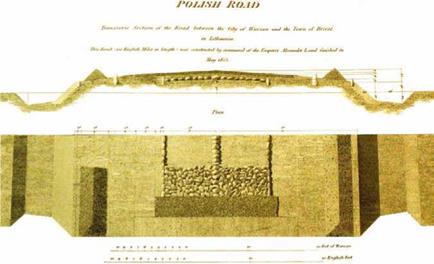Some History
In Europe road construction may date back as far as 3,500 years ago. These early roads were probably largely for ceremonial purposes, over short distances, and may have carried little, if any, wheeled traffic. It was not until the growth of the Roman Empire that a large network of engineered pavements was first constructed (Fig. 1.1). Such was the desire to secure the Empire against enemies and to enhance trade that, at the peak time, about 0.5 km was being built daily. Although foot and hoof traffic probably predominated, those roads were certainly used for wheeled vehicles too.
The engineers responsible for these pavements understood some important truths about pavement drainage – truths which, in practice, sometimes are still not recognised today. Figure 1.2 shows a cross section of a high quality Roman road. It illustrates that its designer:
A. R. Dawson
University of Nottingham, Nottingham, UK e-mail: andrew. dawson@nottingham. ac. uk
A. R. Dawson (ed.), Water in Road Structures, DOI 10.1007/978-1-4020-8562-8_1, © Springer Science+Business Media B. V. 2009
|
Summa crusta – grouted polygonal flagstones on best roads or rough cobbling ongood roads, absent elsewhere Nucleus – compacted sand/gravel mix I++1 ®tatumen – larger stones sometimes sometimes set in a pozzolanic mortar set in a mortar. Usually absent Rudus – stabilised rubble and [—— 1 Agger – stone and soil earthworks to stones < 50mm in size • * • lift road above surrounding ground |
|
|||
|
|||
|
|
||
|
|||
|
|||
|
|||
|
|||
|
|||
|
![]()

Only a small proportion of pavements were built as illustrated, more generally a two layer pavement, comprising nucleus and rudus as explained in the notes to the Figure, was constructed on an embankment (agger – see Fig. 1.2). Despite the economizing on materials, the aim of keeping the construction well-drained remained unaltered.
It was not until the late 1700s and early 1800s that a similar understanding was once again developed. Figure 1.3 shows a cross-section of a main coach pavement as designed by Thomas Telford, the Scottish engineer who worked in the UK and other European countries between about 1800 and 1830. In this design an effort has been made to provide a relatively impermeable surface to prevent water infiltration and a drainable foundation, but the route to lateral drains from these is not well developed.
Despite these early evidences of the understanding that drainage is needed for a well-functioning road, the lesson hasn’t always been fully appreciated. Arthur Cedergren, the American engineer, famously said that “there are three things that a road requires – drainage, drainage and more drainage” (Cedergren, 1974, 1994). He said this many years ago yet, despite many advances in the subject and a huge rise in environmental concerns since he was active, little further has been published in the area. This book is our attempt to redress that omission.
|
Fig. 1.3 Facsimile ofTelford’s design for a road from Warsaw to Brzsec1 (Telford, 1838) |
1 The text at the top of the figure reads “POLISH ROAD / Transverse Section of the Road between the City of Warsaw and the Town of Brzesc in Lithuania. / This Road (100 English Miles) was constructed by command of the Emperor Alexander I. and finished in May 1825.” Nowadays, Brzesc is known as Brest, and forms the border crossing town between Poland and present day Belarus. It lies about 215 km East of Warsaw (Warszawa) not “100 English miles” ^ 160 km as indicated in the figure.
In the following sections the modern manifestation of the same objectives – to keep pavements dry by limiting ingress and assisting drainage – are introduced. Alongside this updating of the age-old principle of drainage, the modern pavement engineer or geo-environmentalist has to consider the quality of the draining water. What chemical components does the water contain? Is that a problem? Where will they go? The following sections seek to introduce this modern concern as well.








Leave a reply